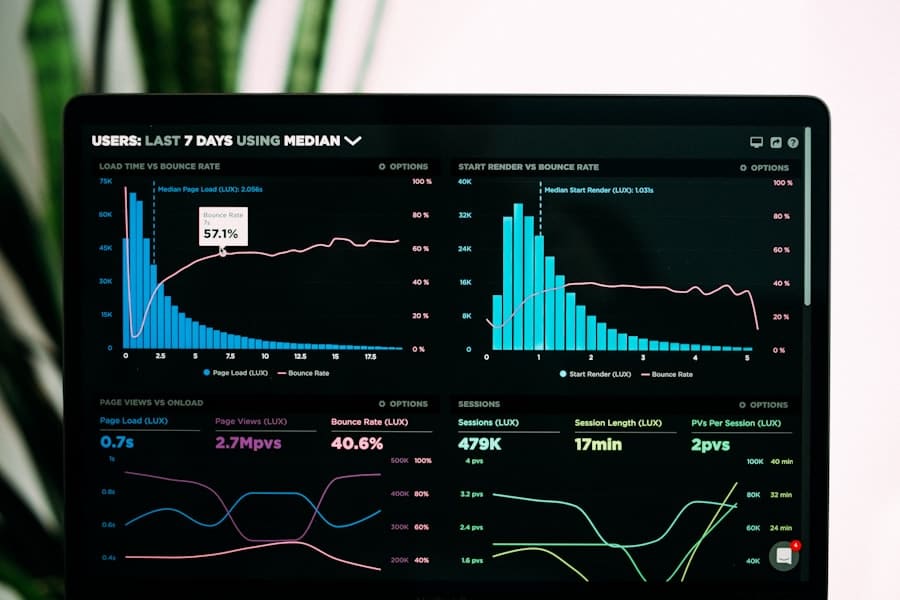Mixed reality (MR) represents a transformative intersection of the physical and digital worlds, enabling users to interact with both environments simultaneously. In the realm of business analytics, MR is emerging as a powerful tool that enhances the way organizations visualize and interpret data. By integrating augmented reality (AR) and virtual reality (VR) technologies, mixed reality allows for immersive experiences that can lead to deeper insights and more informed decision-making.
As businesses increasingly rely on data-driven strategies, the adoption of mixed reality tools is becoming essential for staying competitive in a rapidly evolving marketplace. The application of mixed reality in business analytics is not merely a trend; it signifies a paradigm shift in how data is consumed and understood. Traditional methods of data visualization, such as static charts and graphs, often fail to convey the complexities and nuances of large datasets.
Mixed reality addresses these limitations by providing interactive and engaging visualizations that can be manipulated in real-time. This capability not only enhances comprehension but also fosters collaboration among teams, as stakeholders can share and explore data together in a shared virtual space. As organizations seek to leverage their data assets more effectively, mixed reality stands out as a promising solution that can redefine the landscape of business analytics.
Key Takeaways
- Mixed reality combines virtual and physical elements to enhance data visualization in business analytics.
- Benefits of mixed reality for data visualization include improved understanding of complex data, enhanced collaboration, and immersive experiences.
- Successful case studies of mixed reality implementation in business analytics include improved training, remote collaboration, and enhanced customer experiences.
- The future of mixed reality in data visualization includes advancements in technology, increased adoption in various industries, and new applications for business analytics.
- Challenges and limitations of mixed reality in business analytics include high costs, technical limitations, and potential privacy and security concerns.
The Benefits of Mixed Reality for Data Visualization
One of the most significant advantages of mixed reality in data visualization is its ability to present complex information in an intuitive and engaging manner. Traditional two-dimensional visualizations can often obscure critical insights, especially when dealing with multidimensional datasets. Mixed reality allows users to visualize data in three dimensions, providing a more comprehensive understanding of relationships and trends.
For instance, a sales team could use MR to visualize sales performance across different regions and product lines, enabling them to identify patterns that may not be immediately apparent in conventional reports. Moreover, mixed reality enhances interactivity, allowing users to manipulate data visualizations with gestures or voice commands. This level of engagement encourages exploration and experimentation, leading to more profound insights.
For example, a financial analyst could use MR to adjust variables in a financial model dynamically, observing how changes impact projected outcomes in real-time. This hands-on approach not only makes data analysis more accessible but also empowers users to derive actionable insights without needing extensive technical expertise.
Case Studies of Successful Implementation of Mixed Reality in Business Analytics
Several organizations have successfully integrated mixed reality into their business analytics processes, showcasing its potential to drive innovation and efficiency. One notable example is the multinational technology company Siemens, which has employed mixed reality to enhance its manufacturing analytics. By using MR headsets, engineers can visualize complex machinery data in real-time while working on the shop floor.
This capability allows them to identify inefficiencies and potential issues before they escalate, ultimately leading to improved operational performance and reduced downtime. Another compelling case is that of the automotive giant Ford, which has utilized mixed reality for product development and design processes. By creating immersive 3D models of vehicles, designers and engineers can collaborate more effectively, visualizing how different components interact within the vehicle’s architecture.
The success of these implementations highlights the versatility of mixed reality across various industries and its potential to revolutionize business analytics.
The Future of Mixed Reality in Data Visualization
As technology continues to advance, the future of mixed reality in data visualization appears promising. Emerging trends suggest that MR will become increasingly integrated with artificial intelligence (AI) and machine learning (ML), further enhancing its capabilities. For instance, AI algorithms could analyze vast datasets and automatically generate relevant visualizations tailored to specific user needs.
This synergy between MR and AI could lead to more personalized and context-aware data experiences, allowing users to focus on insights that matter most to their decision-making processes. Additionally, as hardware becomes more affordable and accessible, the adoption of mixed reality tools is expected to grow across various sectors.
Furthermore, advancements in cloud computing will facilitate real-time collaboration among remote teams, enabling them to engage with mixed reality visualizations regardless of their physical location. This evolution will likely democratize access to advanced analytics tools, empowering a broader range of users to leverage data effectively.
Challenges and Limitations of Mixed Reality in Business Analytics
Despite its numerous advantages, the implementation of mixed reality in business analytics is not without challenges. One significant barrier is the initial investment required for hardware and software development. Organizations may face difficulties justifying these costs, particularly if they are uncertain about the return on investment (ROI) associated with mixed reality initiatives.
Additionally, the need for specialized skills to develop and maintain MR applications can pose a challenge for companies lacking in-house expertise. User adoption also presents a hurdle; employees accustomed to traditional data visualization methods may be resistant to change. Training programs are essential to ensure that users feel comfortable navigating mixed reality environments and fully understand the benefits these tools offer.
Furthermore, there are concerns regarding data security and privacy when utilizing cloud-based MR solutions, as sensitive information may be at risk if not adequately protected. Addressing these challenges will be crucial for organizations looking to harness the full potential of mixed reality in their business analytics efforts.
Best Practices for Implementing Mixed Reality in Data Visualization
Define Clear Objectives
First and foremost, it is essential to define clear objectives for using mixed reality tools within the context of business analytics. By identifying specific use cases—such as improving team collaboration or enhancing customer engagement—companies can tailor their MR solutions to meet their unique needs.
Engage Stakeholders and Provide Training
Engaging stakeholders early in the process is another critical step. Involving end-users from various departments ensures that the developed solutions address real-world challenges and align with user expectations. Additionally, providing comprehensive training programs will help employees acclimate to new technologies and foster a culture of innovation within the organization.
Establish Feedback Loops
Regular feedback loops should also be established to continuously refine MR applications based on user experiences and evolving business requirements.
The Role of Mixed Reality in Improving Decision-Making in Business Analytics
Mixed reality plays a pivotal role in enhancing decision-making processes within business analytics by providing immersive experiences that facilitate deeper understanding and collaboration among stakeholders. When decision-makers can visualize complex datasets in three dimensions, they are better equipped to identify trends, correlations, and anomalies that may influence strategic choices. For instance, a marketing team could utilize MR tools to analyze customer behavior patterns across various demographics, allowing them to tailor campaigns more effectively.
Furthermore, mixed reality fosters collaborative decision-making by enabling teams to engage with data visualizations collectively. In a shared virtual environment, team members can discuss insights in real-time, brainstorm solutions, and explore different scenarios together. This collaborative approach not only enhances creativity but also ensures that diverse perspectives are considered before making critical business decisions.
As organizations increasingly recognize the value of collective intelligence, mixed reality will likely become an integral component of their decision-making frameworks.
The Impact of Mixed Reality on Data Visualization in Business Analytics
The integration of mixed reality into business analytics represents a significant advancement in how organizations visualize and interpret data. By offering immersive experiences that enhance understanding and collaboration, MR tools empower businesses to make more informed decisions based on complex datasets. As demonstrated through successful case studies across various industries, the potential applications of mixed reality are vast and varied.
While challenges remain regarding implementation costs and user adoption, best practices can guide organizations toward successful integration of mixed reality technologies into their analytics processes. As we look ahead, it is clear that mixed reality will play an increasingly vital role in shaping the future of data visualization within business analytics, driving innovation and fostering a culture of data-driven decision-making across industries.
A related article discussing the new world of possibilities with the Samsung Galaxy Chromebook 2 360 can be found here. This article explores the innovative features of the Samsung Galaxy Chromebook 2 360 and how it can enhance productivity and creativity for users. The integration of mixed reality technology in data visualization for business analytics is similar to the cutting-edge capabilities of the Samsung Galaxy Chromebook 2 360, showcasing the endless possibilities for technology in various industries.
FAQs
What is mixed reality?
Mixed reality (MR) is a technology that combines elements of both virtual reality (VR) and augmented reality (AR) to create a new environment where physical and digital objects coexist and interact in real time.
How is mixed reality enhancing data visualization in business analytics?
Mixed reality is enhancing data visualization in business analytics by allowing users to interact with and manipulate data in a 3D environment, providing a more immersive and intuitive way to analyze and understand complex data sets.
What are the benefits of using mixed reality for data visualization in business analytics?
Some benefits of using mixed reality for data visualization in business analytics include improved data comprehension, enhanced collaboration among team members, and the ability to identify patterns and trends more effectively.
What are some examples of how mixed reality is being used for data visualization in business analytics?
Some examples of how mixed reality is being used for data visualization in business analytics include creating 3D visualizations of sales data, using spatial analytics to understand customer behavior, and visualizing supply chain data in a virtual environment.
What are the challenges of implementing mixed reality for data visualization in business analytics?
Challenges of implementing mixed reality for data visualization in business analytics include the cost of hardware and software, the need for specialized skills to develop MR applications, and ensuring data security and privacy in a mixed reality environment.



